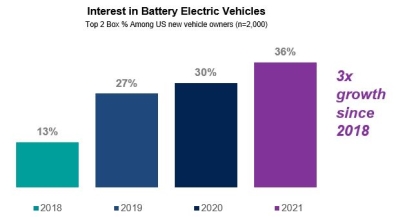
More than a third of U.S. consumers are now considering an EV, according tonew Ipsos data.
NEW YORK— How can the automotive industry make electric vehicles the majority of their sales? The question is vexing companies and dealers across the U.S. as federal regulations aim to make half of the new U.S. auto fleet electric by 2030. More needs to be done to increase EVs’ consumer appeal, with priorities including education on EVs related to cost of electricity, consumer choice of vehicles, federal/state incentives and dealing with range anxiety perceptions.
Ipsos data from the syndicated 2021 Mobility Navigator shows that California, a leader in EVs, can offer clues on what to expect.
In California, just over 10% of sales in 2021 have been battery electric so far compared with just 2% of all vehicle in the U.S. The state has invested heavily over the years to commit to electrification. Its efforts include charging infrastructure, state level rebates, access to HOV lanes, preferred parking, additional taxes on gas and rebates for solar panel programs.
But again, all these efforts have only gotten California to 10% of sales. More must be done to broaden the appeal to reach the thresholds being committed to by automakers. Ipsos Mobility Navigator Study reveals that since 2018, interest in battery electric vehicles has tripled, with over a third of U.S. consumers now willing to consider a battery electric vehicle. This is the highest level we have monitored over the last few years and is an encouraging trend.

But, why are we seeing this increase? Two reasons: increased familiarity with battery electric vehicles and consumer choice. There are more battery electric vehicles coming as consumers search for variety within large SUV and truck categories. Along with this, battery electric vehicles are becoming more affordable and are now offered by mainstream automotive brands, not just luxury brands.
In 2021 alone, the following are battery electric vehicles that are available or will be available by the end of 2021 in the U.S. All key segments will be covered with small and midsize cars, SUV/CUVs and pickup trucks. The variety of vehicle choice enables more consumers to consider battery electric vehicles. Many more choices are coming in the next few years as more automakers commit to electrification.

In 2021, U.S. consumers are increasingly aware of the need to reduce their impact on the environment, providing a clear opening for companies and governments to pitch battery electric vehicles. The importance of boosting familiarity with these consumers cannot be understated at a time when more Americans are paying attention to their environmental footprint. Ipsos recently found a significant increase in consumers’ willingness to consider a battery electric vehicle in 2021 versus 2020, with 69% of US vehicle owners knowing at least a little bit about battery electric vehicles.

In California, where the support has been strongest across the nation, we see familiarity and purchase consideration the strongest. This shows that with effort and education, companies and dealers can have an impact and correlate to higher percentage of sales. In California, knowing a “fair amount” about the offerings translates to higher purchase consideration.

Americans who have more familiarity (know a little or a fair amount) about battery electric vehicles are significantly more interested in considering them in the future. The real driver of consideration is familiarity and reducing the uncertainty for consumers.

Given all this data, what should marketers or companies highlight and inform consumers about?
- Range anxiety: The biggest uncertainty for consumers right now is “range anxiety” and charging. What range is acceptable for drivers and where can they charge their vehicle? How does the charging work? Educating consumers and alleviating concerns about being stranded is a must.
- Cost concerns: Consumers see the increased price tag and don’t realize the cost of ownership savings by using electric versus gas. Electricity is less expensive than gas. And, most consumers don’t realize that the bulk of charging will happen at home, so they won’t be paying the more expensive fast charging often. Plus, there is less maintenance involved with an EV than a traditional gas engine with less moving parts such as no oil changes, no traditional transmission with gears or no radiator, etc. Education about these cost of ownership savings plus how the federal and state incentives/rebates work is extremely important for the industry to get most consumers over the hurdle of purchase from consideration. The key conclusion Ipsos continues to reach from all its data is this: As more consumers become familiar with the basics of battery electric vehicles, they become more interested. Battery electric vehicles are more cost effective to operate, are cleaner to operate and are a blast to drive, with instant torque and acceleration. If you haven’t driven one yet, schedule your test drive across the multiple new vehicles hitting the market today.
The Ipsos Mobility Navigator will provide further insights through 2021, which automotive insiders can immediately use to capitalize on new consumer behaviors such as electrification perceptions and shared mobility usage.
Originally posted on F&I and Showroom


0 Comments
See all comments